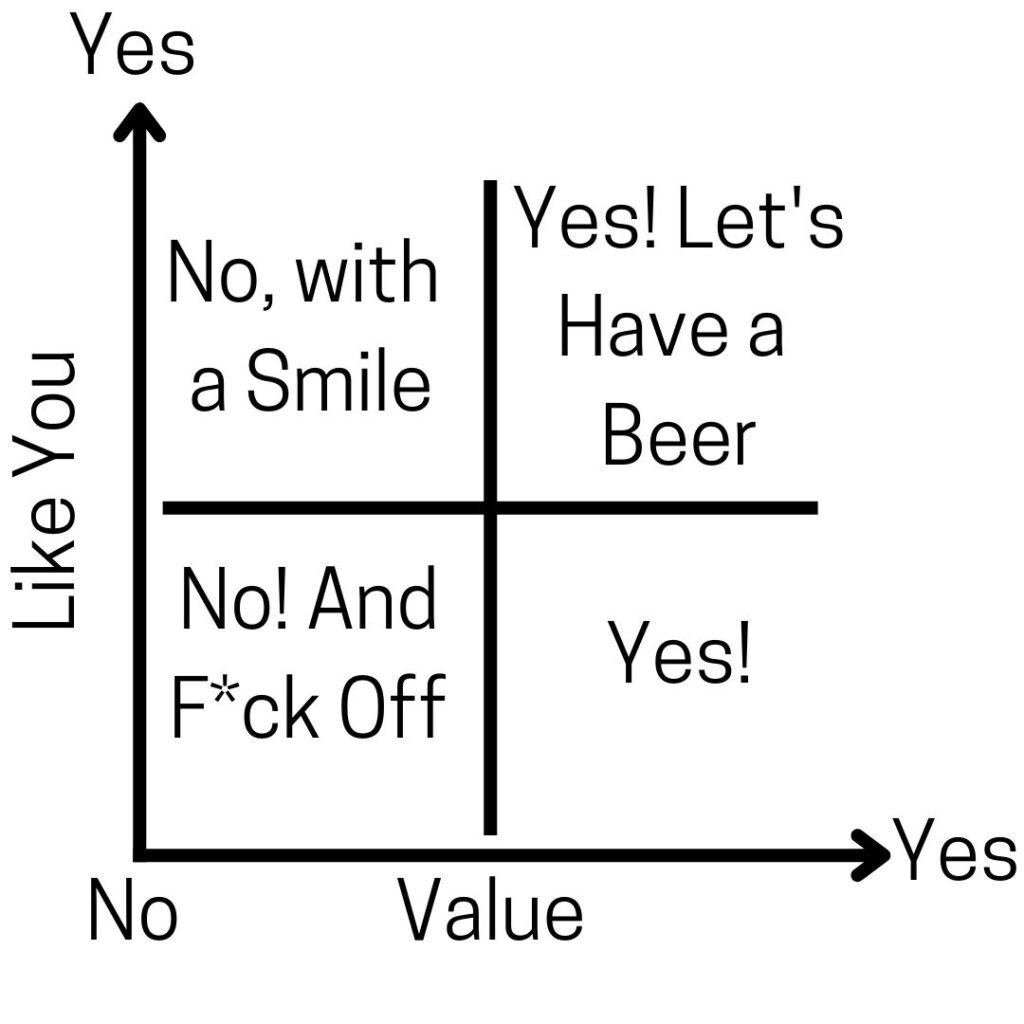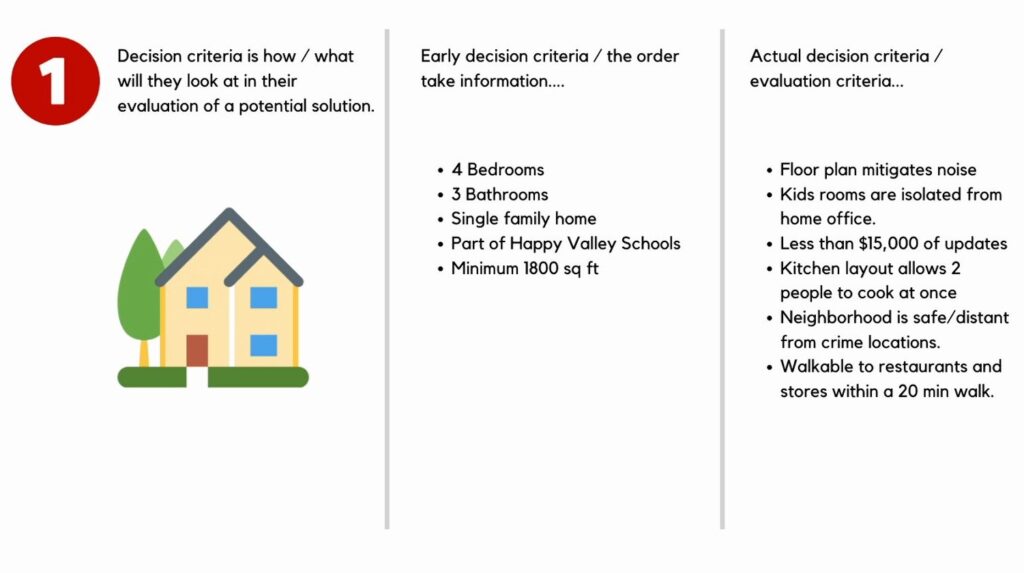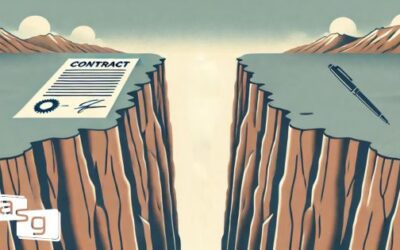All Sales Training Is the Same, Right?
Sandler Sales Training has been a staple of the sales training world for decades. What was once a prominent methodology, the Sandler methodology has lost a step or two as we entered the 21st century. Gap Selling was developed to plug holes that Sandler Sales Training has left behind when it comes to 21st Century selling. Sandler focuses on seven key pieces of a sales including rapport building and upfront contracts. Let’s break down the Sandler Selling system and highlight what works, what doesn’t work, and how Gap Selling can, pun intended, fill the gap.
Bonding and Rapport Building
Attempting to build rapport with a prospect is hurting you more than helping. Sandler sales training has long emphasized the importance of rapport building, but times have changed. Now, before all you Sandler folks grab the pitchforks, we have to give credit where credit is due. In the late 60s and early 70s, Sandler did level-up the sales game connecting with the prospect through, in their words, “more than inauthentic questions”. It’s about more than asking about family photos on their desk, questions like how did you start in the industry, where does your company operate, what trends are affecting your industry?

Likeability vs. Value Matrix
When Sandler sales training was released in 1967, these questions were relevant and necessary. Sales teams didn’t have the technology that we have today: Google, LinkedIn, ChatGPT, etc. As sellers, we can’t waste precious time on these questions/small talk anymore – you need to have these answers before you talk to the prospect. If you must ask the trends in the industry, you’ve lost credibility. What once was an “authentic question” is now just small talk.
We’re no longer trying to build superficial likability. Buyers want credibility and there’s a difference between those two. A buyer in today’s world is only focused on 1 thing in a discovery call – how can I alleviate the problem I have. Don’t waste 5 or 10 minutes of either of your precious time trying to connect with them through slightly less than surface level questions like, “how did you start in the industry?” Dive right in. Don’t try to build rapport or be liked, build credibility through demonstrating your market expertise.
Likeability does not equal credibility. We’ve talked about this many times before, but if you still want to push back against this theory – take a look at our likeability vs. value matrix.
Rapport and likeability are bonuses and aren’t a necessary skill to be a great seller. Start with value, end with value. Leave the small talk at home. Get to the point.
Upfront Contracts
Too much of Sandler Sales Training could be presented to ANY working professional and, if they didn’t care about the presenters feelings, you’d probably hear a collective “duh.” Upfront contracts is one of those. It’s an agenda with some makeup on it to make it sound like a revolutionary sales tactic. There are 5 pieces that make up a UFC, as they call it.
The 5 “Duh’s” of Upfront Contracts
Duh #1 – The purpose of the meeting, contact, and future action
Eliminating the duh – This is an agenda. We don’t need to waste training time or discovery time setting an agenda. That’s what email is for. As Gap Sellers, we get right into the discovery UNLESS we need to manage a misaligned expectation. If the customer starts asking for features or product overview questions, we manage that with a quick “while I could explain the exhaustive list of features and benefits of the product, it’s typically more effective to learn about what is happening on your end so we can focus on only the relevant pieces, does that sound good to you?” Boom. Done.
Duh #2 – The client’s agenda for the meeting or their expectations
Eliminating the duh – Do we need to ask them for their expectations? They have a problem they want solved, that’s why they took the call, that’s their true agenda.
Duh #3 – The sales professional’s agenda for the meeting
Eliminating the duh – Most sales professionals start to lose their prospect here. Most sellers’ agenda is to sell, hit quota, cash a check, etc. Gap Sellers know better. We’re not in the business of selling; we’re in the business of helping. If your agenda for a discovery isn’t to help, you’re not Gap Selling. Your goal should be to diagnose, inform, and make a recommendation if a problem you can solve exists.
Duh #4 – The date, location, and duration of the meeting
Eliminating the duh – We don’t need many words here. This was super important in the 1960s when sales meetings were in-person and calendars hung on the wall. The Sandler selling system emphasizes the importance of ensuring that the prospect adheres to the allocated time available so that you’re not taken aback when they have an “unexpected” fire come up. That fire’s about as real as your date’s friend’s emergency. There’s probably no fire, they just can’t wait to get out of the meeting. Setting an agenda isn’t going to solve this. You need to do a better discovery. Ask better questions and you might find there are less emergencies during your meetings.
Duh #5 – The expected outcome of the meeting or interaction
Eliminating the duh – We can’t really call this duh #5, this is just wrong. How can you define the outcome of the meeting prior to the actual meeting and discovery, unless you have a preconceived notion that you are hunting them and are going to close them. No, don’t do that. The expected outcome is that you’re going to have a conversation, see if there is a problem that exists that you can solve, and then make a recommendation if both parties are a fit for each other. Rather than worrying about closing them as quickly as possible, focus on the next yes, if they’re a fit.
UFC’s are a tactic to lock a prospect into a conversation when they relinquish control. Should you as the salesperson be in control of the meeting? Yes. But don’t hold the prospect hostage to gain control. Use the questions, your expertise, and your ability to diagnose to control the meeting and keep the prospect engaged. Take a look at this eBook and learn what a REAL sales cycle looks like.
Bottom line, UFC’s are both scummy and elementary. Hard pass.
Pain
The Sandler Pain Funnel is a key piece of their training and methodology. Giving credit where credit is due again, the pain funnel was revolutionary in the late 60s. Sandler made an attempt to shift from product-centric selling to focusing on an issue the prospect is having, digging in, and making the product relevant and directly related to this pain.
The problem we see with this method is that salespeople get too eager when they hear a pain they can alleviate AND pain is very often not enough to provide a prospect with the incentive to change.
In Gap Selling, we don’t use the word pain. Instead, we focus on Business Problems, Technical Problems / Root Causes, and Impacts. Features of our products solve technical problems and root causes. BUT, buyers buy to solve the business problem and/or the impact of those problems.
Watch Now: Stop Selling to Pain. It doesn’t Work!
Gap Selling Definitions:
Technical Problems / Root Cause – a missing, broken, or inefficient tool or process, that causes the business problem.
Business Problem – The manifestation of the technical problem in the business, most often related to a KPI
Impact – The definition of how the business problem is, or will, impact the organization i.e. the big picture.
We can live with pain, we can live with technical problems, unless they are tied to a business problem and impact.
A quick analogy, think of a headache. We often turn to the medicine cabinet, grab some ibuprofen and move on with our day. The pain of the headache is briefly subdued by a feature of the drug. But what if we misdiagnosed the pain of the headache? What if the headache is just a pain or a symptom of a larger problem? What if that headache is actually a brain tumor?
Had we seen a doctor as the headache persisted they would’ve asked us a list of questions to discover if the headache was just a headache or a sign of something more. The doctor would run tests, asks us about our eyesight, if we’ve been experiencing fatigue or mood swings, and if our appetite has changed recently? Solving for pain could work, sometimes it is just a headache, but as sellers we only get 1 shot at a true diagnosis. Don’t jump to sell the ibuprofen when the problem could be much deeper.
Budget
Budget is always a sticking point in Gap Selling training and rightfully so, it’s a common objection. However, unlike Sandler Sellers, Gap Sellers almost don’t believe in budgets. Sure, we understand why they exist, and why companies have them, but if you properly Gap Sell, you uncover the business problems AND the impact, then your budget objections will disappear.
How?
Let’s say your product costs $50,000 a year. The prospect has only budgeted $20,000 for a solution. But, you’ve uncovered the trilogy (business problems, technical problem, impact) and you know that without fixing the problem they are losing $20,000 a month or $240,000 a year. The math is right there.
The cost of not changing is far greater than your $50,000 a year solution. There’s your leverage. They will find the budget for your solution if you are able to do the math for them.
When a customer says they don’t have the budget, the deal get’s more complicated but it’s the time to focus on your value proposition. People will always find the “budget” if the value is there.
Watch Now: How to Handle Price Objections in Sales
Decision
The decision criteria is the 5th step in the Sandler Selling method. This is their “Authority” phase. Who, what, when, how, and why does the customer want to move forward? We know that you need to be talking to the right person, someone with influence, but asking beyond that this system is taking the power from the seller and shifting it to the buyer.
Even if you’ve established yourself as the order maker, asking these decision-making questions puts the buyer back in the driver’s seat and begins to chip away at your leverage. In Gap Selling, while we understand decision criteria is an important factor, we focus on the why and the buyer’s evaluation criteria and only after we have made our recommendation.

During each training session, we run through an exercise where we ask participants to assess a recent large purchase they’ve made and work backwards to establish the problems they were solving with their new purchase and the evaluation criteria. Home purchases are often the most interesting. A lot of people don’t understand or haven’t considered the nuances in their purchase decisions.
Think back to the last time you purchased a home – you had a rough framework for what you were looking for in a home – 4 bedrooms, 3 bathrooms, a rough square footage, part of a specific school district etc. These are your early surface-level decision criteria. This is the order take information. If you’re searching in a somewhat populated area, there are likely more than 50 homes that fit this criteria.
Gap Sellers and Order Makers know there is more to this decision than that framework. Why 4 bedrooms? Do you work from home? Is the 4th bedroom and actual bedroom or is it going to be used as an office? If it’s going to be an office, does it need to be a full bedroom rather than a bonus room? Why 3 bathrooms? Do you want a separate master bathroom? Are you okay with guests using the “kids” bathroom?
Does the buyer understand why they have the criteria they have? Using your market expertise, is there additional evaluation criteria the buyer should be aware of? Real estate agents who are order takers will present a buyer with the rough criteria they were presented with. An order making real estate asks the questions similar to our examples and presents a curated list that mostly fits the buyer’s original framework. The agent has built this list with intention and is ready to explain their rationale because they understand the buyer’s motivation for deciding to change.
Fulfillment
Now that we’ve completed the first 5 steps of the Sandler selling process and most of their qualification process, It’s time for the final 2 – fulfillment and post-sell. This is the step where you pitch your solution and be sure that the buyer’s fulfills their end of the agreement.
For Gap Seller’s, fulfillment is the recommendation phase of the sale. You’ve collected all of your notes, found the business problems, root causes, and impacts, and developed your Gap. Now it’s time to present your solution.
We’ve heard the furthest distance in a sale is from mouth to pen and it’s true. This is the phase in the sale where buyer’s start to get cold feet or shortly after the sale where buyer’s remorse sets in. If you’ve done a sufficient job in your discovery then you should know the likelihood that this is going to close. If you’re CRM is developed properly around your methodology, then you should know how well you’re solving their problems.
At ASG we use a 3 tiered scoring system (red, yellow, and green). When we have captured a majority of the pieces in our CRM, we know why the buyer should buy, how it will impact them moving forward, and have discovered enough of a reason for them to change, we rate this deal as a green. The close rates for deals in the green is astronomical – something like 93%. BUT, once a deal slides into the yellow, it drops dramatically. WHY? Because we didn’t take our own medicine, we haven’t uncovered everything and the buyer isn’t convinced we can help. Aka, they don’t see enough value to change.
Post-Sell
Buyer’s remorse is a real pain in the ass for organizations. A happy customer not only keeps them around longer, adding to your bottom line themselves, but they become advocates for your products in their social circles. On the flip side, if your product does not solve their problems, boost their revenue, or becomes too complicated, they’ll quickly abandoned it and go back to the ways they knew.
Your product goes to the trash pile and you’ve lost their trust. Fulfillment is calling you non-stop trying to figure out what went wrong and you’re responding that you gave them everything they asked for. You don’t know why the sale went bad. Well, you just said it yourself, you gave them everything they asked for. You became an order taker. They wanted a feature and you gave it to them. You allowed the buyer to remain in the driver’s seat and you allowed them to self diagnose. What do I mean by this?
Imagine you hear a grinding noise when braking in your car. You search the internet and discover that the noise you’re hearing is an indication that you need to replace your brake pads. You bring the car to a shop and the mechanic asks what you need. You tell them you need brake pads and without doing a proper diagnosis they replace them and send you on your way. At the first stop sign you realize that the problem hasn’t been fixed so you turn around and bring it back but hesitantly. You’ve lost faith in the mechanics ability to address the issue because they allowed you to self diagnose.
Grinding brakes COULD be a sign that you need new pads, but they also could mean that you need new rotors, you could have a bad caliper, or even a wheel bearing has gone bad. But because they allowed you to self-diagnose the issue, they’ve lost your faith. The mechanic is the expert, they should have asked questions like does it only make the sound when you’re braking? Does the steering wheel shudder? Does the noise get worse when turning? Is the car driven regularly?
Don’t allow you buyer to self-diagnose because so very often they are wrong. Human psychology latches onto the first problem that makes sense and makes it near impossible for us to let it go until an expert does a diagnosis. Help your buyers let their self-diagnosis go.
Selling, when done correctly, is about solving your buyers’ and prospects’ business problems so THEY can make more money, grow THEIR business and eradicate any barrier or barriers to their success. And, in the process of helping buyers be successful, companies and salespeople are rewarded with commissions, revenue, references, and repeat business. Selling is a “we” business, not an “us vs them” business.
Old school selling and sales training techniques were about your product and the salesperson (product-centric), and Sandler Sales was built to win in that environment. Selling today, in the 21st-century, is about solving problems and helping prospects and their companies achieve amazing desired outcomes (problem-centric). Gap Selling is a sales methodology built to position salespeople to be that 21st-century trusted business advisor.
Give us a shout and experience a 21st Century discovery for yourself.









0 Comments